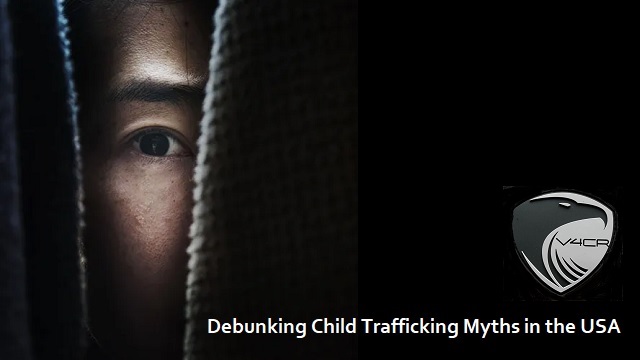Debunking Child Trafficking Myths in the USA & Facing the Truth

Child trafficking is a heinous violation of human rights, with many misconceptions obscuring the real issues. Let’s unpack and demystify these myths, offering a transparent lens into the truth about child trafficking in the USA.
What is Child Trafficking?
The sale and exploitation of children, often for the purposes of forced labor or sexual exploitation. It involves the recruitment, transportation, transfer, harboring, or receipt of minors through force, deception, or coercion. Tragically, child trafficking treats children as commodities, prioritizing profit over their well-being and fundamental rights. This heinous crime occurs globally, transcending borders and socio-economic barriers, and demands urgent attention and collective action to safeguard the vulnerable youth. Read more.
Recognizing the Signs of Child Trafficking:
- Children traveling alone or with non-relative adults.
- Children appearing dominated by an accompanying adult.
- Unexplained school absences or frequent transfers.
- History of runaways or homelessness.
- Child labor with long hours or low pay.
- Expensive possessions or inappropriate clothing.
- Overcrowding or unsafe environments.
- Tattoos or branding hinting at commercial sex trafficking.
- Performance of sexual acts or prostitution.
Dispelling Myths:
Myth 1: Child trafficking mostly happens in developing countries.
Reality: The USA is the main source and destination for child trafficking, with an estimated annual income of $50 billion from child sex trafficking.
Myth 2: Child trafficking mostly involves kidnapping.
Reality: Trafficking methods vary, and most trafficking isn’t through abduction. Kidnapping is one of many tactics, but statistically, it’s the minority of the instances of child trafficking. Over 90% of the time, children are trafficked by family members and/or friends.
Myth 3: Trafficking victims come from low-income backgrounds.
Reality: While socio-economic vulnerabilities can play a role, children from all economic, racial, and social backgrounds can become victims of trafficking. It’s not restricted by socio-economic status, region, or neighborhood type. Traffickers often exploit areas where they believe they won’t be suspected or caught.
Myth 4: If they wanted to leave, they could.
Reality: Many assume that victims of trafficking can easily leave their situations if they wanted. However, traffickers often use manipulation, threats, violence, and other coercive tactics to control and keep their victims from seeking help.
Myth 5: Trafficking involves moving across borders.
Reality: Trafficking doesn’t always involve the transportation of victims across state or national borders. It can occur within the same state, city, or community.
Myth 6: Trafficking children can be easily identified.
Reality: The truth is, most victims are scripted and show subtle signs that may not be obvious to most. Many may overlook a child who is attending their school or church, unwitting to the harsh reality that child may be facing in their home life.
Myth 7: Law enforcement can easily spot and handle trafficking.
Reality: Trafficking cases can be complex, and specialized training is often needed to recognize and handle them appropriately.
Myth 8: Traffickers are sinister strangers:
Reality: It’s a common belief that traffickers are always unknown to the victim. In many instances, traffickers can be family members, friends, or acquaintances who exploit the trust and vulnerability of the child.
Myth 9: Child trafficking is only for sexual exploitation.
Reality: While sexual exploitation is rampant, children face trafficking for many sinister purposes, including forced labor and organ trafficking.
Myth 10: Only girls are trafficked.
Reality: Trafficking doesn’t discriminate by gender. Boys are also victims of trafficking for both sexual and labor exploitation.
Echoes of Trauma: Effects on Child Trafficking Survivors
A. Psychological Trauma:
- Deep-rooted trauma and PTSD become a part of many trafficked children’s lives. This impacts their mental health, relationships, self worth, and perspective of the world.
- What may seem normal or even comforting to the average person may be very off putting and even distressing for survivors. Compassion, grace, and understanding, along with quality trauma-informed therapy are paramount to supporting a survivor’s healing journey.
- If untreated, the persistent trauma can lead to long-term mental and physical health challenges.
Read more on healing and overcoming trauma.
B. Physical Aftermath:
- Trafficked children frequently face health complications and injuries from their experiences. Many have lasting physical symptoms even decades after the trauma.
- Many victims were deprived of basic needs and suffered additional trauma due to subpar living conditions.
- Survivors may take a while to get comfortable around other people, especially crowds or strangers, and feel safe in their surroundings.
Our Collective Role Against Trafficking:
- Government Measures: Strengthen and enforce laws, amplify awareness, and establish dedicated local and federal task forces.
- Community Vigilance: By spotting and reporting suspicious activities, communities can reduce the predator’s ability to operate and prevent countless children from trauma.
- Personal Duty: Awareness, support, and action. Support the organizations on the front lines of the fight against child trafficking in the USA.
In Summary:
Child trafficking remains a dark shadow in our society. The myths and misunderstandings surrounding it only hinder our fight against this crime. With a better understanding and collective responsibility, we can not only raise awareness but also put an end to this atrocious act.
Act now. Dive deeper into preventative strategies in our “Tools & Education” section and stand up against child trafficking in the USA!
EDITORS NOTE: This Veterans 4 Child Rescue column is republished with permission. ©All rights reserved.


Leave a Reply
Want to join the discussion?Feel free to contribute!